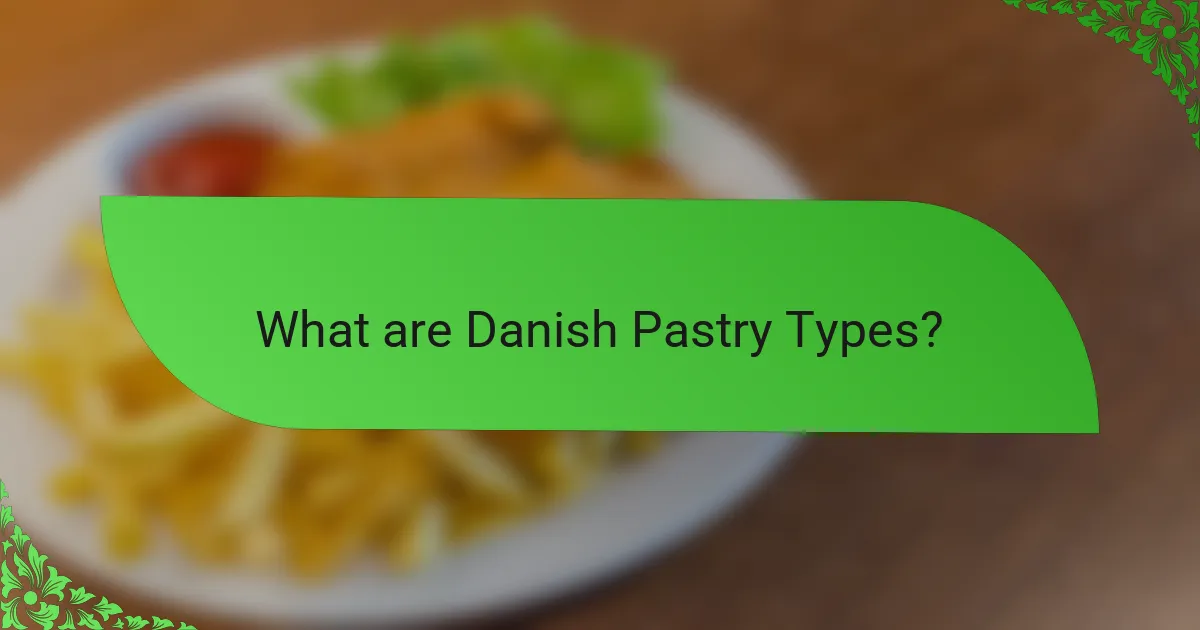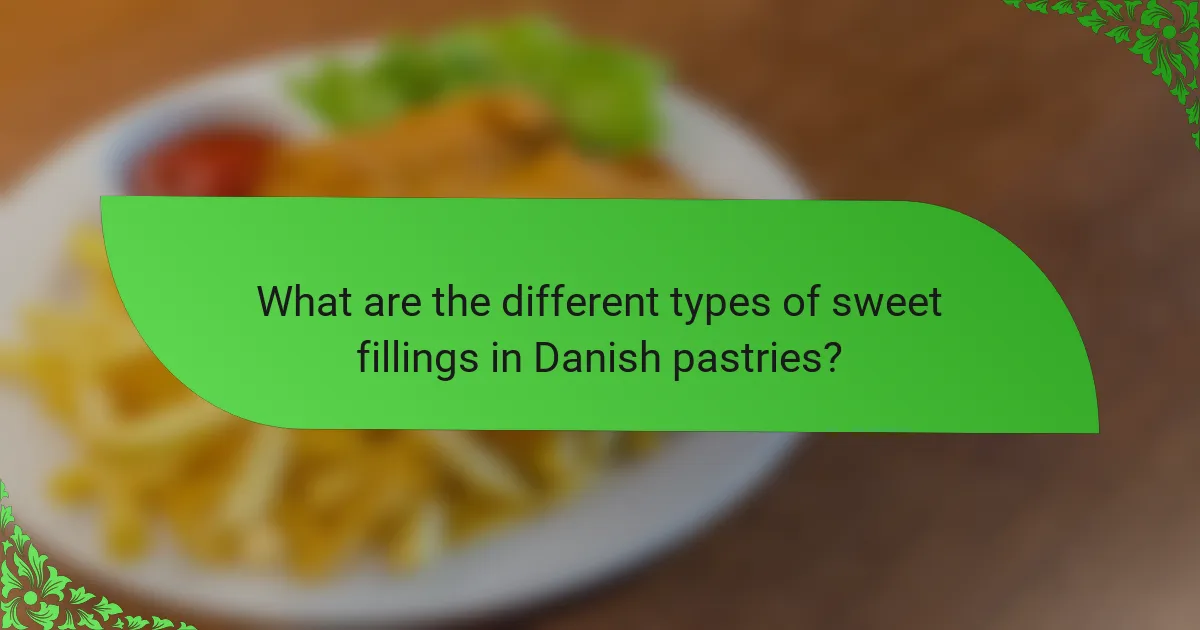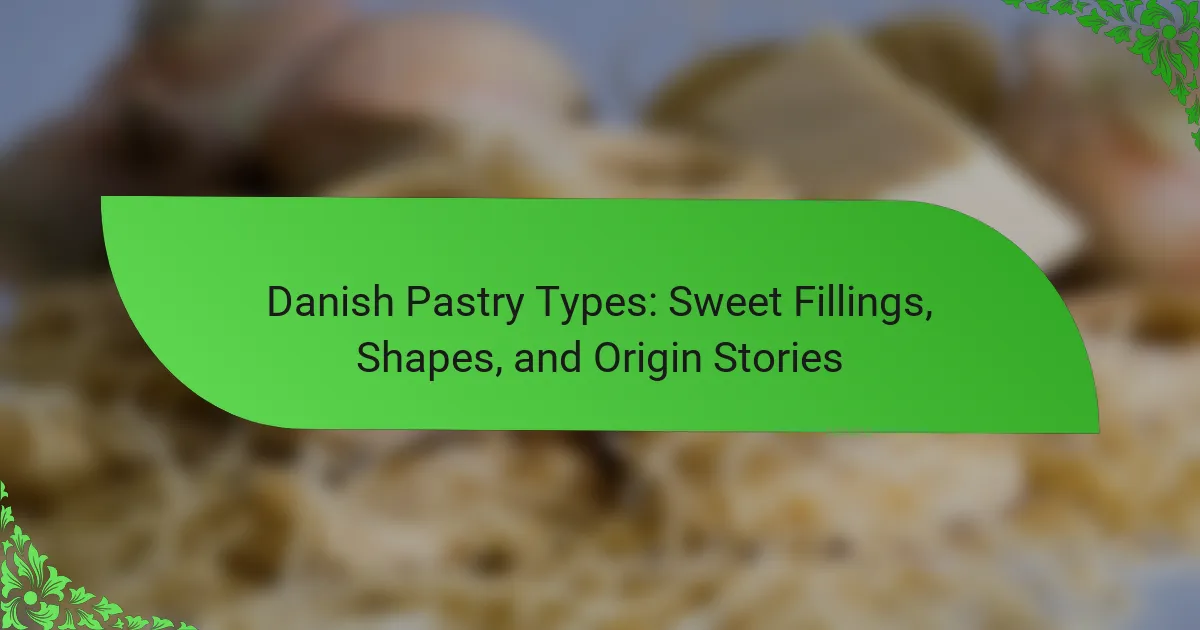Danish pastries, known for their flaky layers and diverse fillings, include various types such as Spandauer, Kringle, and Wienerbrød. Spandauer features sweet fillings like custard or fruit, while Kringle is a twisted pastry often filled with almond paste. Wienerbrød serves as a general term encompassing multiple styles and fillings, including cinnamon rolls and cheese Danish. Each pastry can take on different shapes, such as spirals, knots, and pockets, each filled with a variety of sweet fillings like fruit preserves, cream cheese, almond paste, and chocolate. Originating in Denmark, these pastries gained popularity throughout Europe in the 19th century and continue to be celebrated for their appealing flavors and textures.

What are Danish Pastry Types?
Danish pastry types include various forms such as Spandauer, Kringle, and Wienerbrød. Spandauer features a sweet filling, often custard or fruit. Kringle is a twisted pastry, typically filled with almond paste or fruit. Wienerbrød, a general term for Danish pastries, encompasses numerous styles and fillings. Other types include the cinnamon roll and the cheese Danish. Each type showcases flaky layers created through a lamination process. Danish pastries originated in Denmark and spread across Europe in the 19th century. Their popularity continues to grow due to their diverse flavors and appealing textures.
How did Danish pastries originate?
Danish pastries originated in Denmark in the 19th century. They were influenced by Austrian baking techniques brought to Denmark by bakers. The introduction of laminated dough allowed for the creation of flaky pastries. Danish bakers adapted these techniques to include local ingredients and flavors. The pastries became popular across Europe and eventually in the United States. Today, Danish pastries are known for their sweet fillings and various shapes. Their legacy reflects a blend of cultural influences and culinary innovation.
What historical influences shaped Danish pastry development?
Danish pastry development was shaped by several historical influences. The introduction of puff pastry in the 17th century played a crucial role. This technique originated from Austria and was brought to Denmark by bakers. Danish bakers adapted this method, leading to the creation of unique pastry forms. The influence of French pastry techniques further refined these adaptations. In the 19th century, Danish pastry gained popularity in the United States. This was due to Danish immigrants who brought their baking traditions. Today, these historical influences continue to define Danish pastry’s characteristics.
How did Danish pastries spread beyond Denmark?
Danish pastries spread beyond Denmark primarily through migration and cultural exchange. In the 19th century, Danish bakers moved to other countries, particularly the United States. They brought their pastry recipes and techniques with them. The pastries gained popularity in American bakeries during this time. Additionally, the introduction of Danish pastries to international fairs showcased their appeal. As a result, they became a staple in many countries. Today, variations of Danish pastries exist worldwide, reflecting local tastes and ingredients.
What are the key characteristics of Danish pastries?
Danish pastries are known for their flaky, buttery layers and sweet fillings. They are made from a laminated dough that incorporates butter, creating a light and airy texture. The pastries often feature a variety of fillings, including fruit, custard, or cream cheese. They are typically shaped into spirals, pockets, or braids. Danish pastries are often topped with icing or powdered sugar for added sweetness. Originating from Denmark, these pastries are popular in many countries. They have become a staple in bakeries and cafes worldwide. Their unique combination of texture and flavor makes them a favorite treat.
What ingredients are commonly used in Danish pastries?
Common ingredients in Danish pastries include flour, butter, sugar, yeast, and milk. Flour serves as the base, providing structure. Butter contributes to the flaky texture, while sugar adds sweetness. Yeast is essential for leavening, allowing the pastry to rise. Milk enhances moisture and flavor. Additional ingredients may include eggs for richness and various fillings like fruit or cream cheese. These components create the signature taste and texture associated with Danish pastries.
How does the preparation method affect the texture of Danish pastries?
The preparation method significantly affects the texture of Danish pastries. Techniques such as laminating dough create distinct layers. This results in a flaky and airy texture. The use of cold ingredients helps maintain the dough’s structure during baking. Additionally, resting the dough allows gluten to relax, further enhancing tenderness. Baking at high temperatures promotes a crispy exterior while keeping the interior soft. Variations in butter content also influence texture, with more butter yielding a richer mouthfeel. Overall, each preparation method contributes uniquely to the final texture of Danish pastries.

What are the different types of sweet fillings in Danish pastries?
Danish pastries can have various sweet fillings. Common types include fruit preserves, such as raspberry or apricot. Cream cheese filling is also popular, often sweetened and flavored. Almond paste is another traditional filling, providing a rich, nutty taste. Custard or vanilla cream is frequently used for a creamy texture. Chocolate filling adds a decadent option for chocolate lovers. Poppy seed filling offers a unique flavor profile. Each filling contributes to the overall appeal of Danish pastries.
What are the most popular sweet fillings for Danish pastries?
The most popular sweet fillings for Danish pastries include cream cheese, fruit preserves, almond paste, and custard. Cream cheese filling is often sweetened and flavored, providing a rich texture. Fruit preserves, such as raspberry or apricot, offer a tart contrast to the pastry’s sweetness. Almond paste adds a nutty flavor and is commonly used in various Danish varieties. Custard filling is creamy and smooth, enhancing the overall taste experience. These fillings are widely favored in bakeries and home recipes alike.
How do fruit fillings differ from cream fillings in Danish pastries?
Fruit fillings in Danish pastries are primarily made from fruit purees or pieces, while cream fillings consist of dairy-based mixtures. Fruit fillings provide a tart and sweet flavor profile. They often include ingredients like berries, apples, or citrus. Cream fillings, on the other hand, are rich and smooth, typically made with ingredients like cream cheese or custard.
The texture of fruit fillings is often chunky or gelatinous, depending on the preparation. Cream fillings are creamy and soft, offering a contrasting mouthfeel. In terms of sweetness, fruit fillings can vary based on the fruit used, while cream fillings tend to be consistently sweet.
Nutritionally, fruit fillings may contain vitamins and fiber from the fruit, whereas cream fillings are higher in fat and calories due to dairy content. Both types of fillings serve to enhance the overall flavor and appeal of Danish pastries, catering to different taste preferences.
What unique sweet fillings are found in regional variations of Danish pastries?
Unique sweet fillings in regional variations of Danish pastries include almond paste in Aebleskiver, custard in Kanelbullar, and raspberry jam in Spandauer. Aebleskiver, a Danish pancake ball, often features almond paste as a filling. Kanelbullar, a Swedish cinnamon bun, uses custard for added sweetness. Spandauer, a popular Danish pastry, is typically filled with raspberry jam. Other variations may include cream cheese in certain regions and poppy seeds in Eastern European adaptations. Each regional filling reflects local tastes and traditions, showcasing the diversity of Danish pastry.
How do sweet fillings influence the overall flavor profile?
Sweet fillings significantly enhance the overall flavor profile of Danish pastries. They add a layer of sweetness that balances the buttery, flaky texture of the pastry. Common sweet fillings include fruit preserves, cream cheese, and chocolate. Each filling contributes unique flavors and aromas. For instance, raspberry preserves introduce tartness alongside sweetness. Cream cheese adds a rich, tangy note. Chocolate provides a deep, indulgent flavor. The combination of these fillings creates a complex taste experience. This complexity is essential in appealing to diverse palates. Additionally, the sweetness of the fillings can elevate the overall enjoyment of the pastry.
What role does sweetness play in balancing flavors in Danish pastries?
Sweetness plays a crucial role in balancing flavors in Danish pastries. It enhances the overall taste profile by counteracting bitterness and acidity. The sugar in pastries interacts with other flavors, creating a harmonious blend. For example, when paired with tart fruits, sweetness softens the sharpness. Additionally, sweetness contributes to the perception of richness in buttery dough. This balance makes pastries more enjoyable and palatable. The careful use of sweetness is essential in achieving the desired flavor complexity in Danish pastries.
How can different fillings enhance the texture of Danish pastries?
Different fillings can significantly enhance the texture of Danish pastries. The choice of filling affects moisture content and overall mouthfeel. For instance, fruit fillings add juiciness and softness, creating a contrast with the flaky pastry. Cream cheese fillings contribute creaminess, which enriches the texture and balances sweetness. Nut-based fillings, such as almond paste, offer a dense and chewy element, adding complexity. Additionally, chocolate fillings provide a smooth, rich texture that complements the pastry’s layers. Each filling type introduces a unique texture experience, making the pastry more enjoyable. The combination of these textures can elevate the overall sensory experience of Danish pastries.

What shapes do Danish pastries come in?
Danish pastries come in various shapes, including spirals, knots, and pockets. Common shapes also include squares, circles, and crescents. Each shape can be filled with different sweet fillings. The spiral shape often features fruit or cream cheese. Knots are typically twisted and can contain almond paste. Pockets are folded over the filling, creating a sealed pastry. Squares can be topped with icing or glaze. These shapes are traditional and widely recognized in Danish pastry making.
What are the traditional shapes of Danish pastries?
Traditional shapes of Danish pastries include the spiral, the pinwheel, and the braid. The spiral shape is created by rolling dough with filling into a coil. Pinwheels are formed by folding dough over filling and slicing it into rounds. Braids involve intertwining strips of dough to create a visually appealing design. Other shapes include the square, often filled and folded, and the crescent, resembling a half-moon. Each shape showcases the versatility of Danish pastry dough and its ability to hold various sweet fillings.
How do shapes affect the baking process of Danish pastries?
Shapes significantly affect the baking process of Danish pastries. Different shapes influence heat distribution during baking. For instance, flatter shapes allow for more even browning. Conversely, thicker shapes may require longer baking times to ensure thorough cooking. The shape can also impact the pastry’s texture. Twisted or layered shapes create more surface area, enhancing flakiness. Additionally, shapes that trap fillings may retain moisture better. This can lead to a softer interior compared to open shapes. Overall, the chosen shape directly influences the final product’s appearance and taste.
What creative shapes are emerging in modern Danish pastry designs?
Modern Danish pastry designs are showcasing innovative shapes such as spirals, flowers, and geometric patterns. These creative shapes enhance visual appeal and add unique textures. Spirals often incorporate layers of dough and fillings, creating a delightful presentation. Floral designs feature intricate petal-like formations, making pastries look like edible bouquets. Geometric patterns include triangles and squares, offering a contemporary twist. These shapes reflect current culinary trends that prioritize aesthetics alongside flavor. The evolution in design stems from a blend of traditional techniques and modern artistry.
Why are shapes important in the presentation of Danish pastries?
Shapes are important in the presentation of Danish pastries because they enhance visual appeal and influence consumer perception. The distinct shapes of Danish pastries, such as spirals, braids, and pinwheels, create an inviting and artistic presentation. This variety attracts customers by showcasing creativity and craftsmanship. Additionally, specific shapes can indicate the type of filling or flavor, aiding in customer choice. Research shows that visual presentation significantly impacts food desirability and purchase intent. A well-presented pastry can increase perceived quality and freshness, making shapes a critical element in marketing Danish pastries.
How do shapes influence consumer perception of Danish pastries?
Shapes significantly influence consumer perception of Danish pastries. The visual appeal of a pastry’s shape can evoke emotions and expectations. For instance, round shapes may suggest comfort and indulgence, while triangular shapes can imply sophistication and elegance. Research indicates that consumers often associate certain shapes with specific flavors and qualities. A study by Spence and Piqueras-Fiszman found that the shape of food can alter taste perception. This suggests that the unique shapes of Danish pastries can enhance their attractiveness and perceived quality. Consequently, shapes play a crucial role in shaping consumer preferences and choices.
What techniques can be used to create visually appealing Danish pastry shapes?
Techniques for creating visually appealing Danish pastry shapes include lamination, shaping, and garnishing. Lamination involves folding layers of dough with butter, creating a flaky texture. This technique enhances the visual appeal by producing layers that expand during baking. Shaping can be done by twisting, braiding, or folding the dough into various forms. Common shapes include spirals, knots, and pinwheels, which add visual interest. Garnishing with icing, fruits, or nuts further enhances the presentation. The use of contrasting colors and textures in garnishes makes the pastries more attractive. These techniques are widely used in professional bakeries to ensure that Danish pastries are not only delicious but also visually stunning.
What tips can help in making the perfect Danish pastry?
To make the perfect Danish pastry, ensure to use high-quality ingredients. Fresh butter contributes to a flaky texture. Cold ingredients help maintain the pastry’s structure during baking. Properly laminate the dough by folding and rolling it multiple times. This creates distinct layers essential for the pastry’s rise. Allow the dough to rest in the refrigerator to relax the gluten. This prevents shrinkage during baking. Preheat the oven to the correct temperature for optimal puffing. Bake until golden brown for the best appearance and flavor. Following these tips results in a delicious and visually appealing Danish pastry.
What common mistakes should be avoided when making Danish pastries?
Common mistakes to avoid when making Danish pastries include not using cold ingredients. Cold butter and flour are crucial for achieving flaky layers. Overworking the dough can lead to toughness. It is essential to handle the dough gently to maintain its texture. Skipping the chilling steps can result in poor lamination. Each layer needs to be well-defined for the best rise. Using the wrong type of flour may affect the pastry’s structure. A high-protein flour is recommended for optimal results. Lastly, neglecting to proof the pastries properly can prevent them from rising adequately. Proper proofing is necessary for achieving a light and airy texture.
How can one experiment with fillings and shapes for unique Danish pastries?
One can experiment with fillings and shapes for unique Danish pastries by using diverse ingredients and creative designs. Incorporate various fillings such as fruit preserves, cream cheese, or chocolate. Experimenting with spices like cinnamon or nutmeg can enhance flavors. Shape variations include twists, spirals, or braids to create visual interest. Traditional shapes can be modified with new techniques, like folding or layering. Using different dough types, such as puff pastry or brioche, can also alter texture and taste. Each variation allows for personalization and innovation in Danish pastry making.
Danish pastries are a diverse category of baked goods originating from Denmark, characterized by their flaky layers and sweet fillings. This article explores various Danish pastry types, including Spandauer, Kringle, and Wienerbrød, while detailing their historical influences, preparation methods, and common ingredients. It also examines the impact of different sweet fillings and shapes on flavor and texture, as well as tips for creating visually appealing pastries. Additionally, the article highlights regional variations and the techniques used to innovate within traditional Danish pastry-making.
